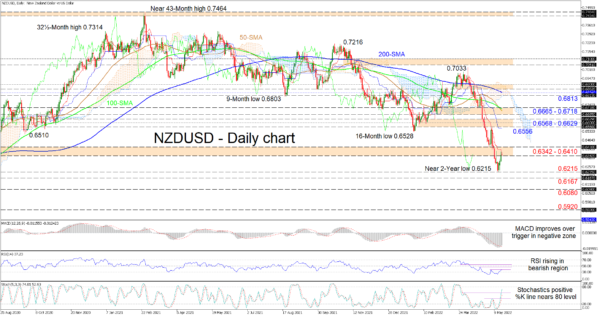NZDUSD improvements from the 0.6215 low are dwindling within the 0.6342-0.6410 region (previous support-now-resistance), which stretches back to mid-June 2020, following a five-week descent from the 0.7033 April high. Furthermore, the diving simple moving averages (SMAs) are sponsoring a revival of the bearish trend in the pair past the near two-year low of 0.6215.
The Ichimoku lines are indicating a pause in negative pressures, while the short-term oscillators are reflecting the latest waning in downward momentum. In their respective bearish zones, the RSI is creeping higher and the MACD has overstepped its red trigger line. Moreover, the positively charged stochastic oscillator is promoting additional upside price action in the pair.
If positive impetus continues to diminish and the price recoils below the 0.6342-0.6410 barrier, initial support could stem from the near two-year low of 0.6215. If selling interest amplifies, the rekindling of the downtrend may then meet the 0.6167 and the 0.6080 respective lows from the latter half of May 2020. Snowballing further, the price may target the 0.5920 May trough, in line with the lows over the mid-April until mid-May 2020 period.
Otherwise, if fresh positive traction unfolds and drives the price north of the 0.6342-0.6410 boundary, buyers may be encouraged to pilot for the 0.6568-0.6629 resistance zone, shaped by the May high and the February inside swing lows. From here, to reinstate confidence in the pair, the price would need to creep beyond the 0.6665-0.6718 resistance barricade, reinforced by the Ichimoku cloud and the falling 50- and 100-day SMAs. Recapturing the area north of the cloud may encourage buyers to challenge the 0.6813 high and the adjacent 200-day SMA of 0.6834.
Summarizing, NZDUSD is exhibiting a bearish bias beneath the 0.6568 high and the SMAs. Additionally, positive prospects in the pair may dwindle further should the price fail to lift above the 0.6342-0.6410 border.














